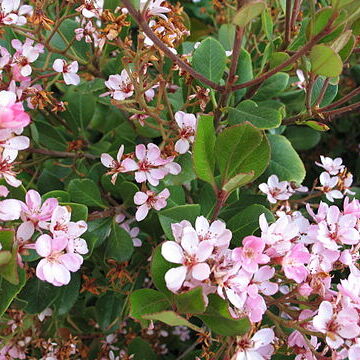Unarmed small trees or shrubs, evergreen. Leaves simple, margins entire or incised, nerves not terminating in the margin. Stipules free. Inflorescence a terminal, compound, rarely simple raceme. Flowers bisexual, 5-merous. Hypanthium obconoid, elongate above the ovary, the free part at inside covered by a disk. Sepals and upper part of hypanthium caducous after anthesis. Petals clawed. Stamens 15-20. Ovary inferior, top covered by the glabrous disk, 2-celled, styles 2, free or connate at base, ovules 2 per cell. Fruit a pome, globular to (ob)ovoid, with a distinct circular scar at top, mesocarp fleshy, thin, endocarp thin. Seeds 1 or 2 per fruit, large, testa thin and firm, endosperm absent, cotyledons thick.
Shrubs or small trees, evergreen. Leaves simple, shortly petiolate, leathery, venation camptodromous, margin serrate or entire; stipules caducous, subulate. Inflorescences in terminal racemes or panicles. Hypanthium campanulate to tubular. Sepals 5, erect or reflexed. Petals 5, white or pink, base shortly clawed. Stamens 15–20. Ovary inferior, 2-loculed, with 2 erect ovules per locule; styles 2 or 3, connate at base. Pome drupe-like, purplish black or bluish, subglobose, succulent, with early caducous sepals leaving an annular ring; seeds 1 or 2, subglobose, large, seed coat thin, cotyledons thickened, plano-convex or semiglobose.

